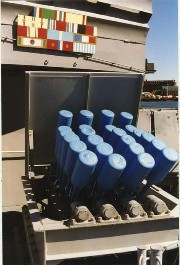Hedgehog (weapon)
|
|
An anti-submarine weapon developed by the Royal Navy during World War II, the Hedgehog was deployed on convoy escort warships such as destroyers to supplement the depth charge. Many small bombs were launched from spiked fittings. The bombs exploded on contact and achieved a higher sinking rate against submarines than depth charges did.
The Hedgehog had three advantages over the depth charge:
- When a depth charge explodes it can take 15 minutes before the disturbance can settle down enough that sonar becomes effective. Many a submarine escaped during that time after an unsuccessful depth charge attack. Since Hedgehog charges explode on contact, if they miss, the submarine can still be tracked by sonar.
- Proximity weapons (such as depth charges) need to be set for the target's correct depth to be effective. Contact fused charges don't have that limitation. In addition, any explosion indicates a 'hit'.
- Until depth-determining sonar became available (the first was the Royal Navy's 'Q' attachment in 1943) there was a 'dead period' during the final moments of the attack when the attacker had no knowledge of what the target was doing. U-boat commanders became adept at sharp changes of direction and speed at these moments, thus making the attack less accurate. Ahead-thrown weapons such as Hedgehog did not give the target the necessary warning of when to dodge.
As a counter-value, the weapon missed out on the cumulative damage effect of repeated explosions just outside the lethal distance that could make it harder for the target to dodge later attacks or force it to return to base for repairs when it did escape.
Technically the weapon was what is called a 'spigot-mortar' or spigot discharger, a type of weapon invented by Lt-Col Blacker, RA. That is the propelling charge was part of the main weapon and worked against a rod (the spigot) set in the baseplate which fitted inside a tubular tail of the 'bomb'. The alternative is the common infantry trench-mortar which is basically a tube and the bomb is dropped down inside the tube firing the propelling charge when it hits bottom.
The Hedgehog was set to be fired when the target was about 250 yards (230 m) ahead of the attacker. The mounting initially was fixed but was later replaced by a gyro-stablised one to allow for the rolling and pitching of the attacking ship.
A salvo was 24 bombs, which were aimed to land in an ellipse or circle about 100 feet (30 m) in diameter.
While more successful than depth-charge attacks eventually (the best kill rate was about 25% of attacks whereas depth-charge attacks never got better than 7%) it was still not good and had a very poor record initially although many of the factors had nothing to do with the design of the weapon.
Data of a single bomb:
- Caliber: 7 in (178 mm)
- weight: 65 lb (29.5 kg)
- explosive charge: 35 lb (15.9 kg)
- range: 200 to 259 m
- sinking speed: 22 to 23.5 ft/s (6.7 to 7.2 m/s)
It was replaced by the Squid mortar and this in turn was replaced by the three-barreled Limbo. A similar weapon to Hedgehog, produced in the USA was Mousetrap. From 1949 a copy of Hedgehog was produced in the USSR as MBU-200, developed in 1956 into MBU-600 with enhanced range of 600 m.
Hedgehog received its name because when unloaded, the rows of empty spigots resembled the spines of a hedgehog.
A land version of Hedghog was developed for exploding landmines and was known as Hedgerow
The spigot discharger principle was also used on the PIAT infantry anti-tank weapon and the Churchill AVRE's Petard demolition gun.
External links
Anti-Submarine Projector Mks 10 & 11 (Hedgehog) (http://www.microworks.net/pacific/armament/mk10&11_hedgehog.htm)de:Hedgehog pl:Hedgehog

